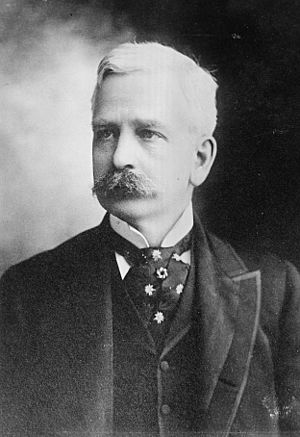Marshall Field facts for kids
Quick facts for kids
Marshall Field
|
|
|---|---|

Marshall Field
|
|
| Born | August 18, 1834 |
| Died | January 16, 1906 (aged 71) |
| Occupation | Founder of Marshall Field and Company |
| Spouse(s) | Nannie Douglas Scott, Delia Spencer |
| Children | Louis Field, Marshall Field Jr., Ethel Field |
| Parent(s) | John Field IV and Fidelia Nash |
| Signature | |
Marshall Field (born August 18, 1834 – died January 16, 1906) was an American businessman. He founded Marshall Field and Company, a famous department store in Chicago. His store was known for its amazing quality and excellent customer service.
Field also gave a lot of money to good causes. He helped fund the Field Museum of Natural History. He also donated land for the campus of the University of Chicago.
Contents
Early Life and First Job
Marshall Field was born on a farm in Conway, Massachusetts. His parents were John Field IV and Fidelia Nash. His family came from early settlers in America.
When he was 17, he moved to Pittsfield, Massachusetts. There, he worked in a store that sold fabrics and clothing, called a dry goods store. He worked with his brother Joseph Field for five years.
In 1856, at age 22, Marshall moved to Chicago, Illinois. He was looking for new chances in the growing West. He found a job at a top dry goods store called Cooley, Wadsworth & Co. This company later became Cooley, Farwell & Co.
Building a Business Empire
Marshall Field quickly moved up in the company. In 1862, he bought a share in the business. The company was then renamed Farwell, Field & Co. Field was very good at business.
In 1865, Field and his partner, Levi Leiter, joined another dry goods store owned by Potter Palmer. The new company was called "Field, Palmer, Leiter & Co." In 1867, Palmer left the company. It was then renamed "Field, Leiter & Company." By 1867, their company made $12 million in sales.
Field's company faced challenges, like the Great Chicago Fire of 1871. But they reopened quickly. They also survived a financial crisis in 1873. By 1881, Field took full control and changed the store's name to "Marshall Field and Company."
New Ways to Shop
Marshall Field changed how people shopped. Before him, stores often used the rule "buyer beware." This meant customers had to be careful about what they bought. Field made shopping a much better experience.
He introduced new ideas that are common today. These included full refunds for returns and consistent prices. He also brought in goods from all over the world. Field told his employees not to push customers to buy things they didn't want. Famous sayings like "Give the lady what she wants" and "The customer is always right" are linked to him.
Wholesale Success
While his retail store is famous today, his wholesale business made more money during his lifetime. Wholesale means selling goods in large amounts to other businesses. In the 1880s, his wholesale business earned five times more than his retail store each year.
The wholesale business even had its own large building, the Marshall Field's Wholesale Store. This building was built in 1887. It wasn't until after Field's death that the retail store made more money than the wholesale side.
Marshall Field did not support labor unions. He did not allow his employees to form unions. He believed that businesses should manage their workers directly.
Family Life
Marshall Field focused on his work and supporting his family. He was a member of important clubs, like the Commercial Club of Chicago.
He was married twice. In 1863, he married Nannie Douglas Scott. They had two sons and one daughter. Sadly, one son, Louis, died as a baby. His other children were Marshall Field Jr. and Ethel Field. His son, Marshall Jr., had a daughter named Gwendolyn. His daughter, Ethel, had two sons, Ronald Tree and David Beatty, 2nd Earl Beatty.
After Nannie died in 1896, Field married his friend Delia Spencer. They did not have children together.
Later Years and Legacy
Marshall Field died in New York City on January 16, 1906. He was 71 years old. He passed away from pneumonia after playing golf. He was buried in the Graceland Cemetery in Chicago.
After he died, his money was held in a trust for his two grandsons. His fortune was valued at $125 million in 1905.
Giving Back to the Community
The Field Museum of Natural History was named after him in 1894. He gave the museum one million dollars. He was not sure about giving the money at first. But a friend, Edward E. Ayer, convinced him that it would be a lasting way to be remembered. After Field's death, the museum received another $8,000,000 from his will.
Marshall Field also helped found the University of Chicago. He worked with John D. Rockefeller to create this university.
Today, a statue of Marshall Field stands by the Chicago River. It is near other important Chicago business leaders.
Images for kids
See also
 In Spanish: Marshall Field para niños
In Spanish: Marshall Field para niños

